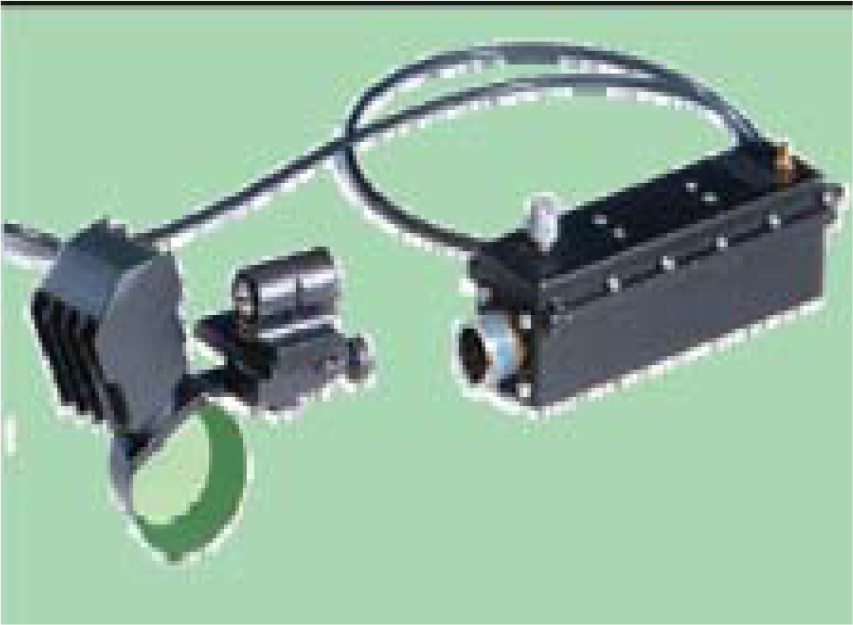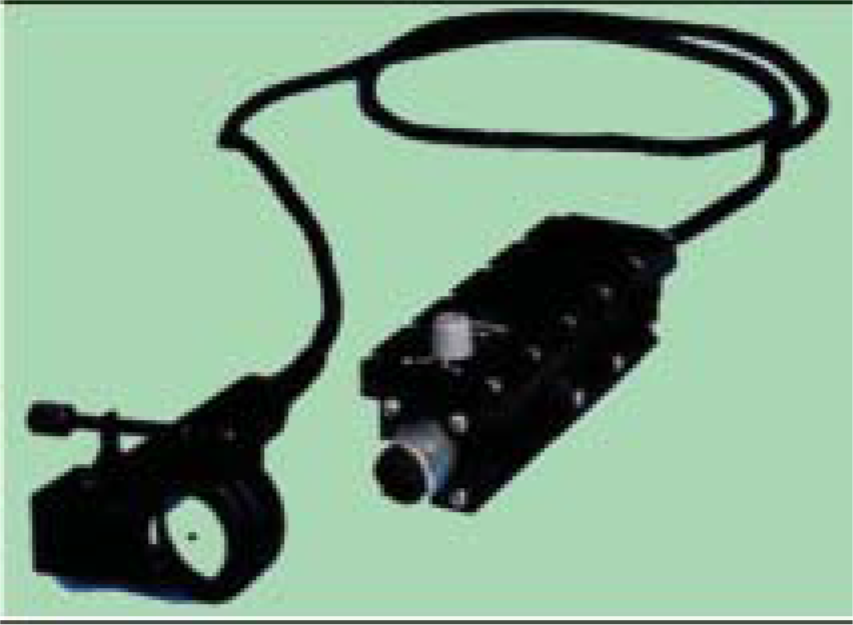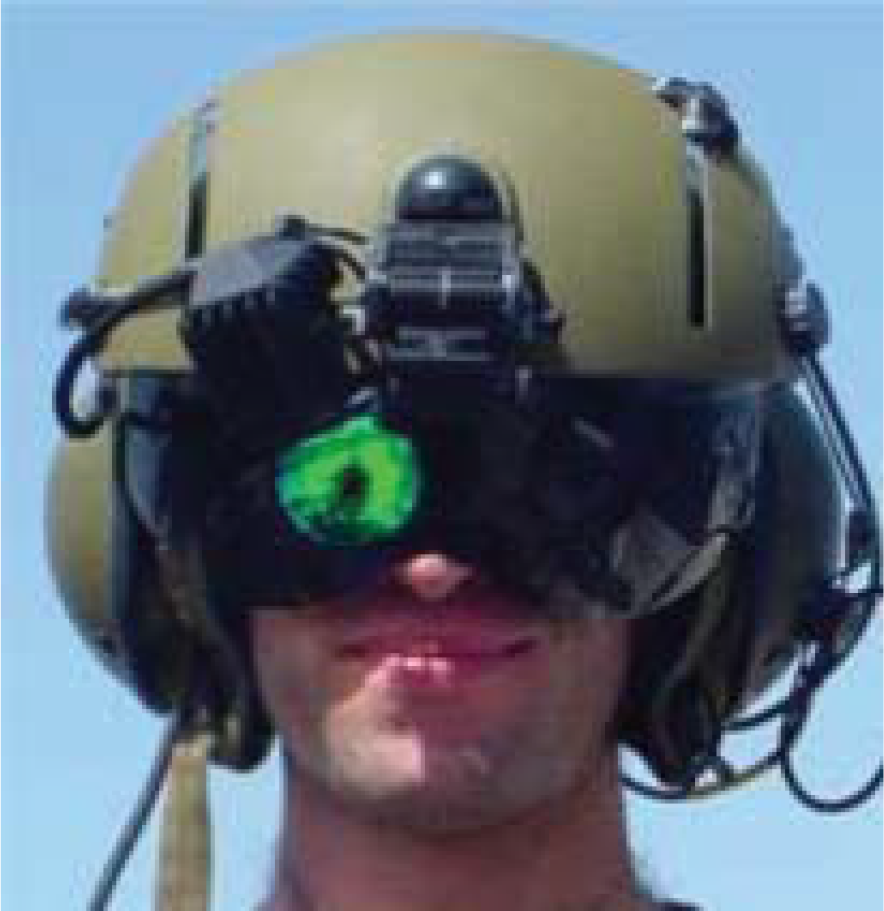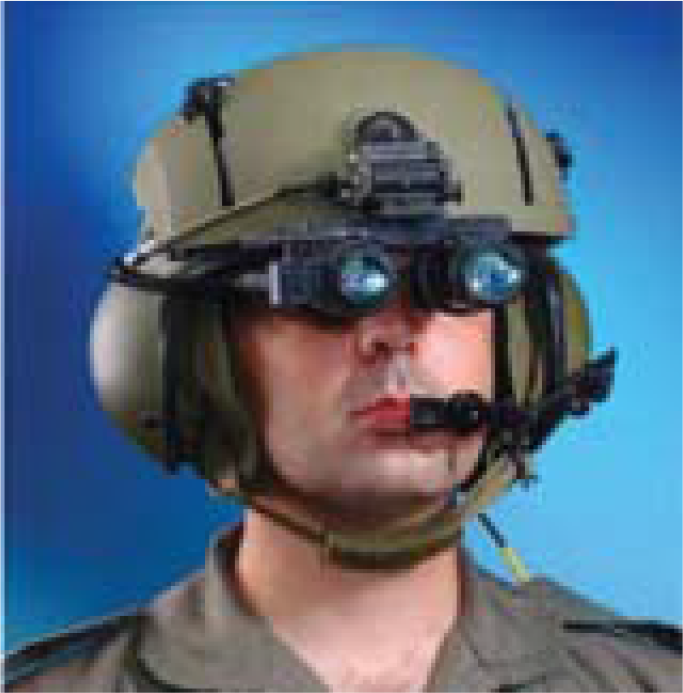Translate this page into:
An ergonomic evaluation of Aviators’ night Vision Imaging System with head-up Display ( ANVIS-HUD)
-
Received: ,
Accepted: ,
Abstract
The ANVIS-HUD-24 system combines the standard Night Vision Goggle image with aircraft flight and engine parameters. The same information is also available during day by using a clear glass monocle. The system is meant to give the crew “head-out” capability by presenting important flight and engine parameters on NVG / clear glass monocle. This precludes the need to look inside the cockpit and the system helps improve overall situational awareness of the pilot. Aeromedical evaluation of the ANVIS-HUD-24 system was carried out ergonomic aspects related to the system were evaluated; so also the human factors aspects related to the usage and operation of the system were assessed. A general assessment of the system was carried out with special reference to the operation of the adjustment knobs and the manner of attachments. Flight trials were carried out with the system and feedback on issues related to the operation of the ANVIS-HUD-24 system were obtained from the aircrew through a questionnaire which covered different aspects such as ease of use, fitment, fatigue, depth perception and disorientation potential. Ergonomic aspects related to the various components of the Day-HUD and Night-HUD systems are discussed. Human Factor issues in the usage and operation of ANVIS-HUD-24 system such as mounting and operation, eye relief, in-flight adjustment, cockpit compatibility, emergency egress, vision outside the cockpit, disorientation potential, discomfort, eye strain and HUD symbology characteristics were analysed. Recommendations for further objective testing for shift in the centre of gravity, decrement in visual acuity and optical characteristics of the system have been made.
Keywords
ANVIS-HUD
Day-HUD
Night-HUD
The ability to locate and visualize the horizon with night vision google (NVG) image aids in better spatial orientation resulting in enhanced situational awareness which, in turn, improves the mission capabilities [1]. However, NVGs possess some inherent design limitations. The visual input provided by NVG does not equal that experienced using the unaided eye during periods of daylight illumination. When compared to unaided daylight flight, many visual parameters, e.g., visual acuity, field of vision (FOV) , depth perception, color vision etc., are compromised [2,3,4]. Multiple variables in the night environment can compound the situation by deteriorating the inherent limitations of NVG image. Awareness of various aeromedical aspects of NVG operations will aid in better flight planning, mission accomplishment and flight safety.
The Aviator's night vision imaging system with (ANVIS-HUD) system combines the standard NVG image with aircraft flight and engine parameters. The same information is also available during day by using a clear glass monocle [5]. The system is meant to give the crew “head-out” capability by presenting important flight and engine parameters on NVG / clear glass monocle. This precludes the need to look inside the cockpit and the system improves the overall situational awareness. This system provides flight information during critical phases of flight such as nape of earth (NOE) and low level flight [6].
Aeromedical evaluation of the ANVIS-HUD-24 system was carried out to evaluate ergonomic aspects related to the system and women human factors aspects related to the usage and operation of the system.
Methodology
The aeromedical evaluation of ANVIS-HUD 24 system covered the following aspects:-
Weight and Dimensions of the components. The weight of the components of ANVISHUD-24 system was measured on a digital weighing machine. The different dimensions of the components were measured using measuring tape and scales.
Ergonomic appreciation. A general check of the ANVIS-HUD-24 system was carried out, particularly the operation of the adjustment knobs and the manner of attachments.
Human Factor aspects. Flight trials were carried out with the system and feedback on issues related to the operation of the ANVISHUD-24 system were obtained from the user (the aircrew) through a questionnaire which covered different aspects such as ease of use, fitment, fatigue, depth perception and disorientation potential.
Objective testing of the shift in the centre of gravity due to the attachment of ANVIS HUD-24 system and decrement in the visual acuity through NVG due to the superimposition of HUD symbology could not be carried out as the system was not offered for ground evaluation at the NVG Lab.

- Day HUD monocle

- Night HUD adapter
Results
Weight and Dimensions of the components.
-
Day HUD
Weight = 230G
Thickness of monocle = 25 mm
Diameter of the distal surface = 45 mm
Diameter of the proximal surface = 35 mm
-
Night HUD
Weight = 70G
Diameter of the add-on adapter including the outer rim = 40 mm
Diameter of the add-on adapter excluding the outer rim = 25 mm

- Day HUD system
System Description
-
Day HUD
Helmet: The CGF Gallet 250 flight helmet was used for mounting the day HUD monocle.
ANVIS Mount: The mount consisted of a mounting plate to which an adaptor was affixed with screws. This mount is affixed on the helmet and NVG is fitted over this mount.
Day monocle connector: The connector consisted of a cylindrical bar which fitted snugly into the mount for the NVG on the helmet
-
Control Knobs: The small control knobs were located over a flat platform attached to the day monocle connector.
(aa) Fore and Aft movement for Eye-Relief: By the adjustment of a small flat cylindrical knurled knob located on the side of the platform, the day HUD monocle can be moved fore and aft to a distance of 25mm for eye relief adjustment. This is adequate to accommodate the visor.
(bb) Lateral movement: By the adjustment of a small flat cylindrical knurled knob located on top of the platform, the day HUD monocle can be moved sideways to distance of 10mm for alignment with the visual axis of eye. This is adequate for optimal alignment.
(cc) Tilt in up-down direction: By the adjustment of a small flat knob located on the side of the platform, the day HUD monocle can be tilted up and down for better alignment.
(dd) Up-down movement: A small flat cylindrical knurled knob located on the helmet mount controlled the up-down movement.
Day monocle: It is a clear glass monocle of 25 mm thickness and it is fitted in front of the right eye. The collimated image is projected onto this monocle by a projector attached to it.
Projector: It consists of the optical system which generates the collimated image and then projects it onto the monocle.
Connector cable: This cable connects the projector with the Electronic unit and transfers data to the projector.
Electronic Unit: This unit is attached to an adapter fitted on the aircraft structure behind the pilot seat. This unit transmits the data regarding the flight, engine and mission parameters from the signal data converter of the aircraft. There is a provision for quick disconnect in this unit.
-
Night HUD
Add-on adapter to NVG: This adapter can be fitted over the objective piece of the Night Vision Goggle on either side. After fitting the adapter, it can be further tightened by a screw provided on top of the adapter. The collimated image is projected onto this adapter by a projector attached to it.
Projector, Connector cable and Electronic Unit: The functions of these components are the same as applicable in the day-HUD system.

- Night HUD system
Discussion
Human Factors in ANVIS-HUD-24 system usage and operations were analyzed based on the feedback obtained from the participating aircrew through a questionnaire administered after the flight trials with the system.
Mounting of the ANVIS HUD-24 system. In the day-HUD system, the connector is directly fitted over the mount on the helmet in place of the NVG. In the night-HUD system, the add-on adapter is fitted over the objective piece of the NVG. The procedure of mounting and removal of both day and night HUD systems was easy and did not present any difficulty during both pre- and in-flight conditions.

- Day HUD system

- Night HUD system
Operation of the knobs for adjustment. In the night-HUD system, the add-on adapter is fitted over the objective piece of the NVG. Hence, other than the adjustment knobs already available for the NVG, no separate adjustment knobs are provided to the night-HUD system. In the day-HUD system, the adjustment knobs are located over a flat platform attached to the day monocle connector. These knobs were easy to operate. There was no difficulty in the adjustment of various knobs. Operation with gloved hand was satisfactory.
Eye Relief. In the day-HUD system, the adjustment range provided was adequate for maintaining a comfortable eye relief to accommodate the visor. The night HUD system uses an adaptor which is directly fitted over the objective eye piece of the NVG and hence, other than the eye relief adjustment already available for the NVG, there is no separate eye relief adjustment for the night HUD system.
In-flight shifting and adjustment. After fitment, both the day and night HUD systems did not shift during the sorties flown in the trials and hence there was no requirement to do in-flight adjustment of both the day and night HUD systems.
Cockpit compatibility. Both the day and night HUD systems did not touch the canopy or any other aircraft structures during ingress, egress and flying activities.
Emergency egress. There is a provision for quick disconnect in the electronic unit. During emergency egress from the helicopter, by just pulling the electronic unit, the quick disconnect is activated which releases the electronic unit from the adapter. The quick disconnect function for safe egress was found to be satisfactory.
Vision outside the cockpit Participating aircrew opined that there was no decrement in the quality of the image of the outside scenario due to superimposition of the HUD symbology. They also observed that there was no difference in distance estimation, depth perception , colour perception and target detection due to the superimposition of the HUD symbology.
Disorientation Potential. During the sorties undertaken, there was no incident suggestive of any disorientation with the use of ANVIS-HUD system. The HUD system provided more orientation information readily in both day and night, negating the requirement to look down at the instruments and this was found to a valuable aid.
Discomfort. In daytime operations, the NVG with a weight of 730 gm is replaced by the clear glass monocle weighing 230 gm. In night operations, the night HUD system weighing 70 gm is added to the NVG. This additional weight was not found to be disturbing and the operating aircrew did not experience any additional neck strain or headache due to the usage of the ANVIS-HUD system.
Eye strain. The operating aircrew did not experience any additional eye strain or watering from the eyes due to usage of the ANVIS-HUD system during the sorties flown in the trials. The duration of sorties varied from 60 to 90 minutes. However, they felt that training is required to get used to viewing the collimated image through the day monocle during flying.
HUD symbology characteristics. Parameters displayed in the HUD symbology include aircraft reference, horizon line, angle of pitch and roll scale with pointer, barometric altitude, vertical speed scale with pointer, radar altitude, ground speed, air speed, distance to waypoint, heading scale and velocity vector. The brightness level of the symbology can be adjusted. Participating aircrew felt that the range available for brightness control was adequate. The contrast level was fixed and found to be adequate. Operating aircrew did not experience any distortion of the symbology during the sorties.
The field of view of the symbology in the night HUD system is 32 degrees over the 40 degree night vision field of the NVG. In the day HUD system, the field of view of the symbology is 25 degrees and the aircrew felt that it was adequate. The colour of the symbology is green in the day-HUD and yellowish-green in the night-HUD.
Summary
The procedure of donning and doffing of both day and night HUD systems was found to be easy during both pre-flight and in-flight conditions.
The adjustment knobs were easy to operate even with gloved hands.
The range of movement available in all directions is satisfactory.
After fitment, both the day and night HUD systems did not shift during the sorties flown in the trials.
The components of the ANVIS HUD system did not touch the canopy or any other aircraft structures during ingress, egress and flying activities.
The quick disconnect function for safe egress was found to be satisfactory
Participating aircrew felt that there was no decrement in the quality of the image of the outside scenario and there was no difference in distance estimation, depth perception and colour perception due to the superimposition of the HUD symbology.
No incident suggestive of disorientation was encountered during the sorties undertaken with the ANVIS-HUD system.
The operating aircrew did not experience any additional neck strain or headache due to the addition of weight in the attachment of the ANVIS-HUD system.
The operating aircrew did not experience any additional eye strain or watering from eyes due to the usage of the ANVIS-HUD system.
Participating aircrew felt that the range available for brightness control of the symbology was adequate.
Operating aircrew did not experience any distortion of the symbology during the sorties. They felt that the contrast and field of view available were adequate.
Recommendations
Objective testing of the shift in the centre of gravity due to the attachment of ANVIS HUD system, decrement in the visual acuity through NVG and assessment of the optical characteristics of the day and night HUD systems is advisable to be carried out to corroborate the subjective feedback from the aircrew.
In addition, it is suggested that aircrew training is required to familiarize then to view the collimated image through the day monocle during flying.
Conclusion
Aeromedical evaluation of the ANVIS-HUD-24 system was carried out and various ergonomic aspects related to the system were evaluated and also the various human factor aspects related the usage and operation of the ANVIS-HUD-24 system were assessed. Objective testing of the system is recommeded to be carried out.
Conflict of interest: None
References
- “Human Factors and safety considerations of night vision systems flight”. USAARL Report No. 89-12. Fort Rucker, AL;
- [Google Scholar]
- “ Human Factors issues in the use of night vision devices” In: 35th proceedings of he Human Factors Society. 1991. p. :1502-06.
- [Google Scholar]
- “ Helicopter flights with night vision goggles- Human factors aspects”. NASA TM 101039.
- [Google Scholar]
- “ Micro-Heads-Up Display for Enhancement of Night Vision Goggle Operations” In: AGARD-CP-379 : Advisory Group for Aerospace Research and Development. 1985. p. :22-24.:7-1-24.
- [Google Scholar]
- “ Night Vision Support Devices :Human Engineering Integration” In: AGARD-CP-379 : Advisory Group for Aerospace Research and Development. 1985. p. :22-24.:6-6-24.
- [Google Scholar]






